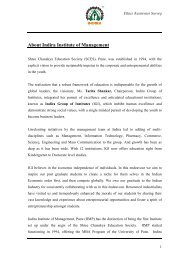IMR JAN 2013 - Indira Institutes
IMR JAN 2013 - Indira Institutes
IMR JAN 2013 - Indira Institutes
You also want an ePaper? Increase the reach of your titles
YUMPU automatically turns print PDFs into web optimized ePapers that Google loves.
Green Marketing"accountable" time and the 1990s was"power in the marketplace" time. Over thoseyears, people started demandingenvironmentally friendly products andservices, and the organizations felt politicaland public pressure to go green. Thenecessity to increase consumers' awarenessof corporate efforts to meet sustainablestandards, the need to identify consumers'preferences for green products, thepossibility of charging a premium price gaverise to a new trend in the marketing field, theso-called Green marketing (Peattie andCrane, 2005)."Green Marketing" refers to holisticmarketing concept wherein the production,marketing consumption an disposal ofproducts and services happen in a mannerthat is less detrimental to the environmentwith growing awareness about theimplications of global warming, nonbiodegradablesolid waste, harmful impact ofpollutants etc., both marketers andconsumers are becoming increasinglysensitive to the need for switch in to greenproducts and services. While the shift to"green" may appear to be expensive in theshort term, it will definitely prove to beindispensable and advantageous, cost-wisetoo, in the long run Green marketing wasgiven prominence in the late 1980s and1990s after the proceedings of the firstworkshop on Ecological marketing held inAustin, Texas (US), in 1975. Manyorganizations want to turn green, as anincreasing number of consumers' ant toassociate themselves with environmentalfriendlyproducts.According to Jacquelyn Ottman, (author of"The New Rules of Green Marketing:Strategies, Tools, and Inspiration forSustainable Branding" (Greenleaf Publishingand Berrett-Koehler Publishers, February2011)from an organizational standpoint,environmental considerations should beintegrated into all aspects of marketing - newproduct development and communicationsand all points in between. The holistic natureof green also suggests that besides suppliersand retailers new stakeholders be enlisted,including educators, members of thecommunity, regulators, and NGOs.Environmental issues should be balancedwith primary customer needs. Thepastdecade has shown that harnessingconsumer power to effect positiveenvironmental change is far easier said thandone. The so-called "green consumer"movements in the U.S. and other countrieshave struggled to reach critical mass and toremain in the forefront of shoppers' minds.While public opinion polls taken since the late1980s have shown consistently that asignificant percentage of consumers in the U.S.and elsewhere profess a strong willingness tofavor environmentally conscious productsand companies, consumers' efforts to do so inreal life have remained sketchy at best. One ofgreen marketing's challenges is the lack ofstandards or public consensus about whatconstitutes "green," according to JoelMakower, a writer on green marketing. Inessence, there is no definition of "how good isgood enough" when it comes to a product orcompany making green marketing claims.This lack of consensus-by consumers,marketers, activists, regulators, andinfluential people-has slowed the growth ofgreen products, says Makower, becausecompanies are often reluctant to promotetheir green attributes, and consumers areoften skeptical about claims18 <strong>Indira</strong> Management Review - Jan <strong>2013</strong>








